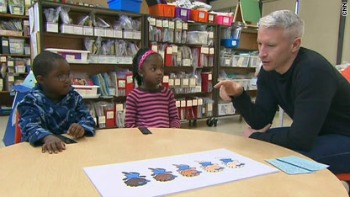
By NICK CHILES
A CNN study on race relations has yielded a news tidbit that is likely to spread across the media like a forest fire: By the age of 13, according to the study, a majority of African-American children have a subconscious racial bias against white children.
The study said that though black children still look kindly on race relations when they are 6, their views grow more pessimistic as they get older.
While many will want to view these results as some kind of smoking gun showing the widespread existence of “reverse racism,” what the study reveals is the nuanced, complicated racial world that all American children live in—a world where the realities of racial bias and group identification are in a constant state of flux, sometimes changing as quickly the shifting sands on a windswept beach.
Black children have to make the same calculations as every other child when they are making friends, adjudging enemies, forming cliques and clubs and posses that will sustain them through the emotional traumas of adolescence: Does this person have my best interests at heart, will they be there for me when I need them, do I like being around them, will they defend me in the face of attack or conflict? This last one is especially crucial.
The answers to these questions are easy when children are young, and their awareness of the world around them and its rules and intricacies are limited. Group membership at age 6 is a simplistic notion, based on factors that will have nothing to do with skin color—I like to play with her because she likes dolls and I do too; he runs fast like me so we’re friends; we both like to draw so we spend a lot of time together.
But something starts to happen when the junior high school years creep up. Skin color starts to become a factor in decision-making. Every black person who has grown up in a racially mixed environment knows exactly what I’m talking about. Your best white friend starts acting a little weird around you, maybe begins to spend more time with girls who look more like her. As kids start noticing the opposite sex, unwritten rules of racial separation begin to take shape. Almost in a form of pre-emptive self-protection, many of the black kids start hanging together—even kids who had no use for each other a few years earlier. Similarly, white kids start spending more time together. The group membership starts to take shape that will become one of the defining realities of their lives.
Surely there is still plenty of mixing—and the instances of mixing seem to be more frequent now than they were in previous decades. But it is still clear that when adolescent kids are looking for comfort in a group, a sense of membership and belonging, they are going to gravitate toward the kids who look like them. They don’t have to be psychic to look out at their futures and see that this is what is expected of them—this is likely the world their parents live in, after all. Sure, sometimes the racial separation is pushed by their families, but I don’t even think the family pressures are key in this phenomenon. This filtering would occur without a word from the parents or older siblings. It’s almost like an adolescent rite of passage for black kids—when junior high comes, you start forming race-based cliques, as a defense against the coming storm, as a way of feeling like you belong to something bigger than yourself. I saw it in my own life, as did my wife. And I see it happening now with my kids.
And, yes, the CNN study might show that a majority of African-American children have a subconscious racial bias against white children by the age of 13, but the study also revealed something else: African-American children had an overall better view of race than their white counterparts. So let’s not get too riled up here. There’s no reverse discrimination conspiracy afoot. What we are seeing is a normal and expected part of adolescence. What we are seeing is the reality of American life, reflected in our little ones.
RELATED POSTS:
1. {On the Parenting Post} Young, Gifted & Black
2. Here’s To Hoping It Won’t Matter To My Babies (and Their Friends) If They’re Black or White
3. WELCOME TO A COLOR STRUCK WORLD
Denene Millner
Mom. NY Times bestselling author. Pop culture ninja. Unapologetic lover of shoes, bacon and babies. Nice with the verbs. Founder of the top black parenting website, MyBrownBaby.
- Web |
- More Posts


One, by the time they are 13, it’s likely they, or someone they know, has had an adverse encounter, and they were old enough to understand and/or remember it.
Two, they’re listening and understand more of what’s being said around and to them, and in mass media. Lots of negative messages, sometimes even by well-meaning parents who are simply trying to prep their children for the harsh realities of the world, as they see it.
Three, at that age, unfortunately, many white children still don’t have to deal with race beyond acknowledging it exists. Theirs is a world in which they most likely are the predominant race and there is a certain sense of entitlement that has nothing to do with wealth. Thus, the nuances of race still have yet to be a big deal for them, in many cases. MHO.